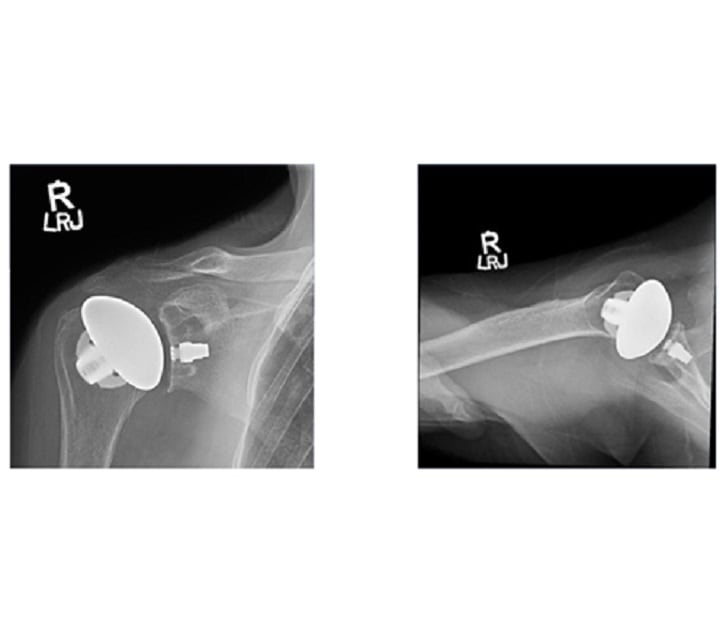April 11, 2023
Pre-operative x-rays

Pre-operative x-rays
Radiographs of the shoulder demonstrate significant osteoarthritis.
In a 2022 Journal of Shoulder and Elbow Surgery (JSES) Reviews, Reports & Techniques article reviewing the relevant literature and surgical technique, John W. Sperling, M.D., an orthopedic surgeon at Mayo Clinic in Minnesota, and colleagues found that stemless anatomic total shoulder arthroplasty demonstrates promise for patients.
"We now have rigorous, prospective, randomized studies — the gold standard — which shows stemless shoulder implants have many advantages for our patients," he says.
Intra-op images of the glenoid

Intra-op images of the glenoid
Intra-operative view shows preparation of the glenoid component (left); hybrid glenoid component with porous ingrowth metal is used for long term fixation (center); placement of the glenoid component is shown (right).
In Dr. Sperling's practice, over 95% of patients who are undergoing anatomic shoulder arthroplasty are candidates for stemless shoulder replacement. To be eligible, patients must have suitable bone quality for the stemless implant.
"We have seen many older patients, even in their mid-to-late 80s, who are candidates for this less invasive option," he says.
Intra-operative images of the humerus

Intra-operative images of the humerus
A stemless humeral component maximizes bone preservation (left); the offset of the humeral head is titrated to optimize the soft tissue tension (center); the stemless humeral component allows the surgeon to match the patient's anatomic version an inclination (right).
Previously, orthopedic surgeons performed a stemmed total shoulder arthroplasty. Many surgeons have now switched to stemless anatomic shoulder arthroplasty due to a demonstrated track record of solid humeral fixation. In addition, Dr. Sperling says that surgeons have noted several key benefits of stemless implants compared with stemmed implants, including less of the following:
- Blood loss.
- Operative time.
- Bone removal.
- Postoperative pain.
"We have learned over time the multiple benefits of using a shorter and shorter stem," he says. "This is derived from removing less of a patient's own humeral bone. The next step in the evolution was to remove the stem and have a completely stemless implant."
Dr. Sperling cites several benefits for the orthopedic surgeon performing the surgery. One of these benefits is the ability to more accurately replicate the patient's native anatomy compared with a stemmed implant. Additionally, there is now available technology on the humeral head to fine-tune the soft tissue balance of the shoulder.
Post-operative radiographs

Post-operative radiographs
Post-operative radiographs show a stemless anatomic shoulder arthroplasty.
"This technology allows me to dial the humeral head the exact amount and direction to optimize soft tissue tension," he says.
Complications
Complication rates have been shown in peer-reviewed literature to be low for this procedure, says Dr. Sperling. For example, the stemless implant's loosening rate is extremely low, with one large prospective randomized study with minimum two-year follow-up showing 100% radiographic success. The percentage chance of requiring additional surgery per year is about 1%.
If a patient's shoulder requires revision surgery in the future, the stemless shoulder implant facilitates the revision and is easier for the surgeon and for the patient's recovery.
Outcomes
In the JSES-published study, Dr. Sperling and colleagues found outcomes for stemless shoulder implant to be consistently good. Across a breadth of studies from countries around the world, stemless anatomic shoulder arthroplasty significantly improved range of motion and pain for patients. Pain relief, he explains, is the primary driver for this surgery.
"The No. 1 complaint I hear from my patients is difficulty sleeping due to shoulder pain," says Dr. Sperling.
"The development of new technology in shoulder arthroplasty together with improved multimodal pain modalities has decreased the barriers and the burden for our patients," he says. "The pain after shoulder replacement is typically less than with a knee replacement. Patients usually are off strong pain pills in a few days."
Availability of stemless shoulder implant
In Europe, stemless shoulder implants have been available for more than 15 years. In the U.S., the procedure has been available for more than five years. Currently, the stemless shoulder implant is increasing in usage, now performed throughout the U.S. and worldwide. Mayo Clinic in Minnesota has extensive stemless shoulder implant experience, says Dr. Sperling, including primary, complex and revision shoulder replacement surgery.
The distinctive features of Mayo Clinic in Minnesota's stemless shoulder implant surgery include:
- Experience. Mayo Clinic in Minnesota performs more shoulder replacements than any other center in the world, according to Dr. Sperling.
- Efficiency. Surgery takes one hour or less and is performed as an outpatient procedure or with only one night's stay in the hospital. All the stitches are absorbable with no sutures needing removal. Patients spend six weeks in a soft arm sling. After a lesson from a physical therapist, patients complete all therapy on their own from home for five minutes three times a day. Many patients send X-rays at six weeks from a hometown medical center and are not required to return for a formal recheck visit at Mayo Clinic.
Dr. Sperling says that the stemless implant is an exciting development in shoulder replacement and has made a significant impact in the ability to take care of patients.
For more information
Marigi EM, et al. Stemless anatomic total shoulder arthroplasty: Surgical technique and review of the literature. Journal of Shoulder and Elbow Surgery Reviews, Reports & Techniques. 2022;2:442.
Refer a patient to Mayo Clinic.
Disclosure
Mayo Clinic is collaborating with Zimmer Biomet in the development of one type of stemless shoulder implant. Dr. Sperling is part of this collaboration. Mayo Clinic and Dr. Sperling have a financial interest in the Zimmer Biomet stemless shoulder implant.